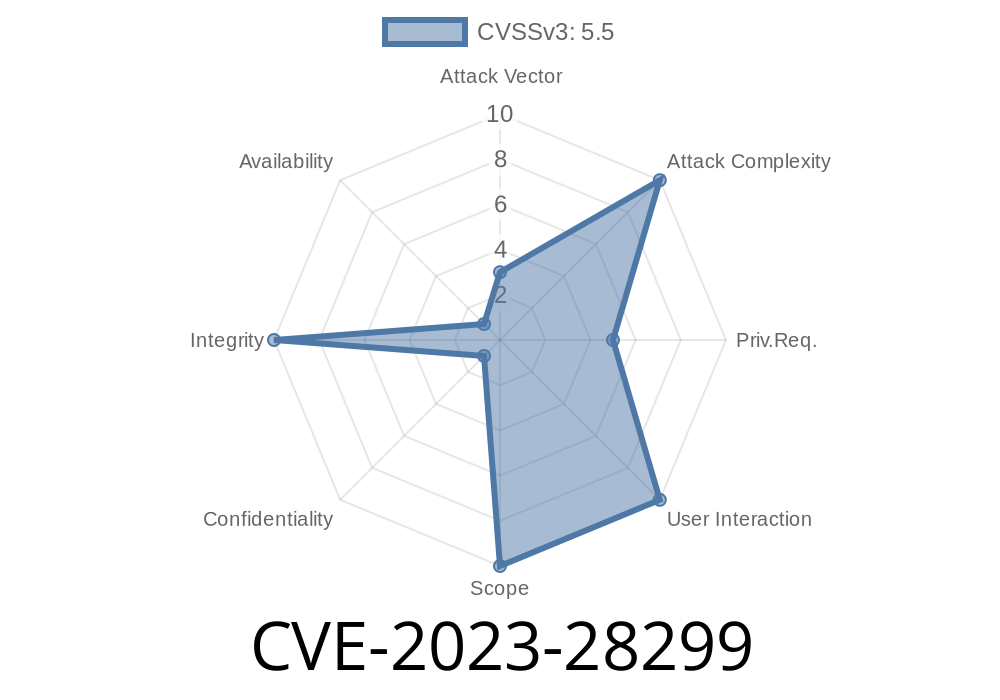The CVE-2023-28299 vulnerability, a critical spoofing vulnerability, was recently discovered in Microsoft Visual Studio, the popular Integrated Development Environment (IDE) used by millions of developers worldwide. It has the potential to compromise source control systems like Git and other Version Control Systems (VCS).
This article will provide an in-depth analysis and discuss the details of this security flaw, including what it means for developers, the potential exploit scenarios, and how you can mitigate the risks associated with it.
What Is CVE-2023-28299?
CVE-2023-28299 refers to a spoofing vulnerability in Microsoft's Visual Studio, which allows an attacker to craft malicious repositories impersonating legitimate sources. This deception can lead developers to inadvertently commit, push or pull sensitive or malicious code changes from the forged repositories. For official details and information on this vulnerability, refer to the NIST National Vulnerability Database - CVE-2023-28299.
How Does It Work?
An attacker can exploit this vulnerability by creating a malicious repository with specially crafted path names. These path names would falsely appear in Visual Studio as originating from a genuine remote repository. Developers who use the IDE without knowing the repository is compromised could then fall prey to this spoofing attack.
Here's a simplified code snippet illustrating how the spoofing attack could be carried out
// Legitimate remote repository URL
https://github.com/legitimateuser/project.git
// The attacker creates a malicious repository with a
// specially crafted path name, as shown:
// Malicious repository URL
https://github.com/malicioususer/fakeproject.git/../legitimateuser/project.git
In this example, the attacker creates and hosts a malicious repository (fakeproject), then crafts the path to include the target legitimate repository (project.git). When the developer clones, pulls, or pushes using the malicious link, Visual Studio will display it as valid. Potential consequences include loss of sensitive data or unintentional incorporation of malicious code into their projects.
Potential Exploit Scenarios
1. An attacker could pretend to be a contributor to an open-source project, sharing a malicious repository disguised as a genuine one. Unsuspecting maintainers may pull changes from the attacker's repository, leading to the inclusion of malicious code in the project.
2. Spoofed repositories could be employed in phishing campaigns, where a targeted developer is induced to clone, pull, or push code to the malicious repository. This could result in the unintentional disclosure of sensitive intellectual property or embedding of harmful code.
How to Mitigate CVE-2023-28299 in Your Projects
To protect your projects and repositories from this spoofing vulnerability, consider implementing the following measures:
1. Upgrade Visual Studio: Microsoft has issued a patch to address this issue. You can find the appropriate version of Visual Studio for your system in their official release notes. Make sure to upgrade to the latest version to benefit from this fix.
2. Double-check Repository URLs: Always verify the authenticity of the repository URLs that you clone, pull, or push to. Note that this step only reduces the risk of attacks but doesn't eliminate them entirely.
3. Use Signed Commits: Encourage contributors to sign their commits with PGP/GPG keys to ensure authenticity. Git has built-in support for verifying signed commits, and you can find detailed instructions on how to configure it in the official Git documentation.
4. Educate Your Development Team: Ensure all members of your development team, especially those with write access to repositories, are aware of this vulnerability and the steps necessary to address it.
5. Implement Repository Access Controls: Restricting write access to only trusted users helps mitigate the risk of unauthorized code changes. Additionally, use repository access controls to enforce separation of duties and limit potential damage.
Conclusion
CVE-2023-28299, the Visual Studio spoofing vulnerability, poses a significant risk to developers and their projects. By following the suggested mitigation steps and staying informed about potential security threats, you can help safeguard your projects against compromise. Always make sure to use the latest version of Visual Studio and any other tools in your development environment to ensure the best protection against vulnerabilities.
Timeline
Published on: 04/11/2023 21:15:00 UTC
Last modified on: 04/19/2023 20:30:00 UTC
